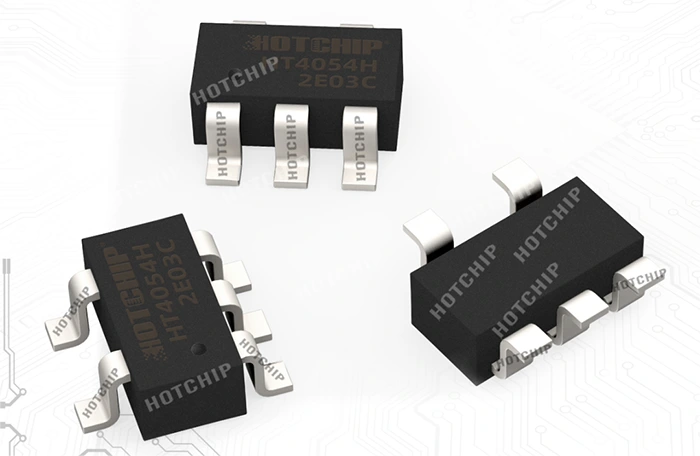Portable electronic devices can be said to be everywhere. As the main source of energy supply, lithium batteries are very important for charging management. The 4054 charging chip IC is a chip that plays a key role in this field.

1. What is a 4054 charging chip IC
The 4054 charging chip IC is a constant current/constant voltage linear charging management chip for a single lithium-ion battery. It is specifically designed to provide safe and efficient charging management for single-cell lithium batteries, ensuring that the battery can be charged correctly and extending its service life. This type of chip usually uses a small package, which is easy to integrate into various portable electronic devices, such as mobile phones, tablets, Bluetooth headsets, mobile power supplies, etc.
2. Working principle of 4054 charging chip IC
Constant current charging stage
When the 4054 charging chip IC starts to charge the lithium battery, it first enters the constant current charging mode. In this stage, the chip will charge the battery with a relatively stable current to quickly increase the battery power. The size of the charging current can be set by an external resistor, which allows users to adjust the charging current according to the battery capacity and charging requirements.
For example, if the battery capacity is small, a smaller charging current can be selected to avoid overcharging and damage to the battery; for large-capacity batteries, the charging current can be appropriately increased to shorten the charging time.
Constant voltage charging stage
As the battery power continues to increase, the battery voltage gradually increases. When the battery voltage approaches the set charging voltage (usually 4.2V), the 4054 charging chip IC automatically switches from constant current charging mode to constant voltage charging mode.
During the constant voltage charging stage, the chip keeps the battery voltage stable at 4.2V, while the charging current gradually decreases. This is because as the battery power approaches saturation, the internal resistance of the battery will gradually increase, and the charging current needs to be reduced to prevent overcharging.
Charging termination stage
When the charging current drops to 1/10 of the set value (the so-called “C/10”), the 4054 charging chip IC automatically terminates the charging cycle. This function ensures that the battery will not continue to charge after it is fully charged, thereby avoiding damage to the battery caused by overcharging and extending the battery life.
3. Main features of 4054 charging chip IC
Efficient charging
The 4054 charging chip IC adopts a linear charging architecture with high charging efficiency. It can effectively transfer the energy of the external power supply to the lithium battery and reduce energy loss.
Compared with the traditional charging method, the linear charging method can achieve fast charging without generating too much heat, which improves the speed and efficiency of charging.
Built-in protection function
Overtemperature protection: During the charging process, if the chip temperature rises to a certain level, the 4054 charging chip IC will automatically reduce the charging current to prevent the chip from overheating and damage. When the temperature returns to normal, the charging current will gradually return to the set value to ensure the safety and reliability of the charging process.
Overcharge protection: When the battery is fully charged, the chip will automatically terminate charging to avoid damage to the battery caused by overcharging.
Undervoltage lockout: If the input voltage is too low, the chip will enter the undervoltage lockout state and stop charging to protect the battery and chip from low voltage.
Strong compatibility
The 4054 charging chip IC is compatible with various types of lithium batteries, including lithium-ion batteries, lithium polymer batteries, etc. At the same time, it can also adapt to different power inputs, such as USB power, adapter power, etc., providing users with more charging options.
Fewer peripheral components
The peripheral circuit design of the 4054 charging chip IC is simple, and only a small number of external components are needed to achieve the complete charging function. This not only reduces the cost and complexity of the circuit, but also improves the reliability and stability of the circuit.
Status indication function
Many 4054 charging chip ICs have a charging status indication function, which outputs different level signals through a pin to indicate the charging status, such as charging, charging completed, fault, etc. Users can understand the progress and status of charging based on this indication signal, which is convenient to use.
4. Application scenarios of 4054 charging chip IC
Mobile devices
Mobile devices such as mobile phones, tablets, and digital cameras are the main application areas of 4054 charging chip ICs. These devices usually use lithium batteries as power sources and require an efficient and safe charging management chip to charge the battery. The small size and efficient charging characteristics of the 4054 charging chip IC make it very suitable for integration into these mobile devices.
Portable electronic products
The 4054 charging IC is also widely used in portable electronic products such as Bluetooth headsets, wireless keyboards and mice, and smart watches. These devices have small battery capacity and high requirements for charging speed and charging efficiency, and the 4054 charging chip IC just meets these needs.
Smart home devices
Smart home devices such as smart door locks and smart cameras usually use lithium batteries as backup power sources and require a reliable charging management chip to charge the battery. The stability and safety of the 4054 charging chip IC make it an ideal choice for smart home devices.
Power tools
Power tools such as electric drills and electric saws usually use lithium batteries as power sources and require an efficient charging management chip to charge the battery. The high charging efficiency and powerful protection functions of the 4054 charging chip IC can ensure the safe charging of the battery and extend the battery life.
5. Precautions for using the 4054 charging chip IC
Correctly select the charging current
When using the 4054 charging chip IC, you need to correctly select the charging current according to the battery capacity and charging requirements. If the charging current is too large, the battery may overheat, be damaged or even explode; if the charging current is too small, the charging time will be extended.
Pay attention to heat dissipation
Although the 4054 charging chip IC has an over-temperature protection function, it still generates a certain amount of heat during the charging process. Therefore, it is necessary to pay attention to heat dissipation when designing the circuit to ensure that the chip can work within the normal temperature range.
Avoid reverse battery connection
Reverse battery connection may damage the 4054 charging chip IC and the battery, so it is necessary to pay attention to the correct connection of the positive and negative poles when connecting the battery.
Choose a suitable power supply
The 4054 charging chip IC can adapt to different power inputs, but it is necessary to pay attention to whether the voltage and current of the power supply meet the requirements of the chip. If the power supply voltage is too high or the current is too large, the chip may be damaged.
In short, Hotchip’s 4054 charging chip IC is also a lithium battery charging management chip. It has the advantages of efficient charging, built-in protection function, strong compatibility, etc., and is widely used in various portable electronic devices. When using the 4054 charging chip IC, it is necessary to pay attention to the correct selection of charging current, pay attention to heat dissipation, avoid reverse battery connection, and choose a suitable power supply to ensure the safety and reliability of charging.
